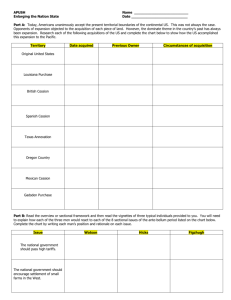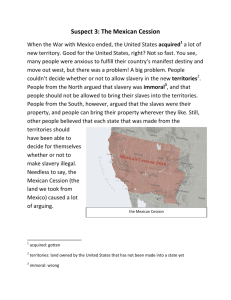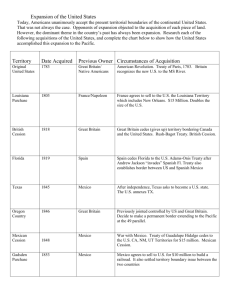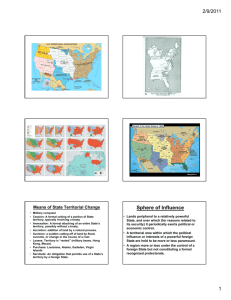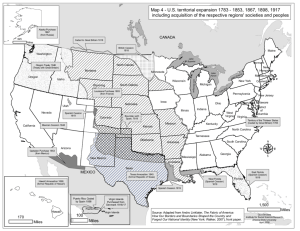US Territorial Acquisitions as the Result of War
advertisement
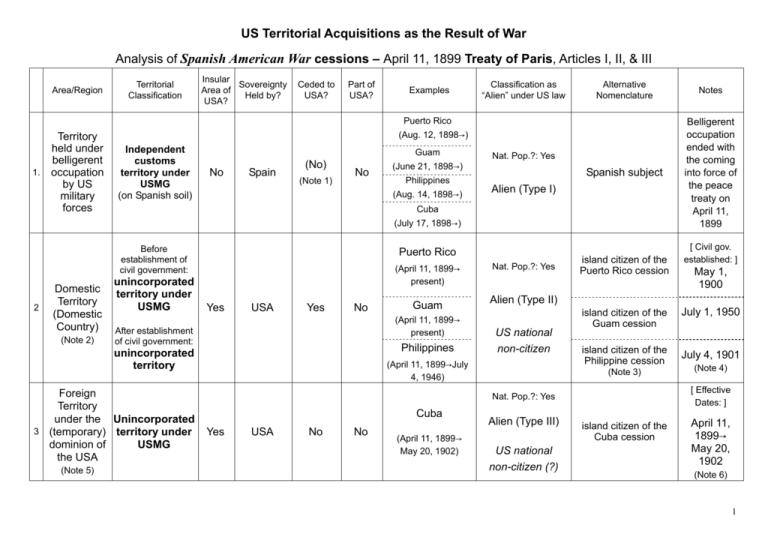
US Territorial Acquisitions as the Result of War Analysis of Spanish American War cessions – April 11, 1899 Treaty of Paris, Articles I, II, & III Area/Region Territorial Classification Insular Sovereignty Area of Held by? USA? Ceded to USA? Part of USA? Examples Classification as “Alien” under US law Alternative Nomenclature Notes Spanish subject Belligerent occupation ended with the coming into force of the peace treaty on April 11, 1899 Puerto Rico 1. Territory held under belligerent occupation by US military forces (Aug. 12, 1898→) Independent customs territory under USMG (on Spanish soil) Guam No Spain (No) (Note 1) No Nat. Pop.?: Yes (June 21, 1898→) Philippines (Aug. 14, 1898→) Alien (Type I) Cuba (July 17, 1898→) Before establishment of civil government: 2 Domestic Territory (Domestic Country) (Note 2) unincorporated territory under USMG Puerto Rico (April 11, 1899→ present) Yes USA Yes No (April 11, 1899→ present) After establishment of civil government: Philippines unincorporated territory Foreign Territory under the Unincorporated 3 (temporary) territory under USMG dominion of the USA (Note 5) Guam Nat. Pop.?: Yes island citizen of the Puerto Rico cession US national non-citizen island citizen of the Guam cession July 1, 1950 island citizen of the Philippine cession July 4, 1901 (Note 3) USA No No (April 11, 1899→ May 20, 1902) Alien (Type III) US national non-citizen (?) (Note 4) [ Effective Dates: ] Nat. Pop.?: Yes Yes May 1, 1900 Alien (Type II) (April 11, 1899→July 4, 1946) Cuba [ Civil gov. established: ] island citizen of the Cuba cession April 11, 1899→ May 20, 1902 (Note 6) 1 US Territorial Acquisitions as the Result of War Analysis of World War II in the Pacific cessions – April 28, 1952 San Francisco Peace Treaty, Article 2b Area/Region 1. 2 Territory held under belligerent occupation by US military forces Domestic Territory (Domestic Country) (Note 2) Territorial Classification Insular Sovereignty Ceded to Part of Area of Held by? USA? USA? USA? Example Independent customs territory under USMG (on Japanese soil) (with administrative authority for the occupation delegated to the Chinese Nationalists) Before establishment of civil government: unincorporated territory under USMG No Japan (No) (Note 1) No Taiwan Alien (Type I) Notes Japanese subject Belligerent occupation ended with the coming into force of the peace treaty on April 28, 1952 Nat. Pop.?: N/A Yes USA Yes No (none) [ Civil gov. established: ] Alien (Type II) US national non-citizen unincorporated territory (Note 7) Alternative Nomenclature Nat. Pop.?: Yes (Oct. 25, 1945→) After establishment of civil government: Foreign Territory under the Unincorporated 3 (temporary) territory under USMG dominion of the USA Classification as “Alien” under US law ----- Nat. Pop.?: Yes Taiwan Yes USA No No (April 28, 1952→ present) Alien (Type III) US national non-citizen (?) (Note 8) island citizen of the Taiwan cession TRA alien [ Effective Dates: ] April 28, 1952 →present January 1, 1979→present (Note 9) 2 US Territorial Acquisitions as the Result of War This chart extrapolates the concept of having “eligibility” to carry some type of US passport back to earlier eras, even though most persons did not carry passports before the 1950’s. The special circumstances of (1) trust territories, or (2) Indian reservations in the fifty states may overlap with insular law to some extent, but are not considered. Foreign Territory held by US military forces under belligerent occupation (without any territorial cession) may be said to be under the administrative control of the USA, but is not insular and hence is not considered here. [Note 1]: A person who is a dual citizen of his/her home country and the USA would of course be qualified to carry a US passport. [Note 2]: The terminology of “domestic country” and “island citizen” comes from the ruling in Gonzales v. Williams, 192 U.S. 1 (1904). [Note 3]: The people of Puerto Rico were collectively naturalized as US citizens in March 1917. The people of Guam were collectively naturalized as US citizens in August 1950. The Philippines became independent on July 4, 1946, and the people became citizens of the Republic of the Philippines. [Note 4]: Military occupation is conducted under military government. United States Military Government (USMG) jurisdiction over Puerto Rico, Guam, and the Philippines ended on the following dates respectively: May 1, 1900; July 1, 1950; and July 4, 1901. [Note 5]: Cuba was a “limbo cession” with the USA as the (principal) occupying power and qualifies as an insular area. US Insular Law applies to Cuba because it is "inside" the principle of cession by conquest which was confirmed by cession by treaty. In DeLima v. Bidwell 182 U.S. 1 (1901), it was held that "Cuba is under the dominion of the United States." [Note 6]: The people of Cuba became citizens of the Republic of Cuba on May 20, 1902. [Note 7]: Taiwan was a “limbo cession” with the USA as the principal occupying power and qualifies as an insular area. US Insular Law applies to Taiwan because it is "inside" the principle of cession by conquest which was confirmed by cession by treaty. This is a similar situation to Cuba after the Spanish American War. [Note 8]: In the Insular Cases (beginning 1901) the US Supreme Court held that even without any actions by the US Congress, “fundamental 3 US Territorial Acquisitions as the Result of War rights” under the US Constitution apply in all unincorporated territories. So-called “fundamental rights” include life, liberty, property, and due process of law under the Fifth Amendment. According to the precedent in Kent v. Dulles, 357 U.S. 116 (1958), and subsequent INS interpretations, the right to travel is a part of the "liberty" of which a citizen, or other person owing allegiance to the United States, cannot be deprived without due process of law under the Fifth Amendment. The right to travel also includes the right to obtain a passport. Hence, the Taiwanese are entitled to carry new Taiwan passports issued under US administrative authority. If the US State Dept. does not accept default status of US national non-citizen for native Taiwanese people, then some new category of travel document, such as TRA Alien Passport or Taiwan Cession Passport, will have to be issued. By way of clarification, there is no valid rationale under international law to consider native Taiwanese persons as Republic of China citizens/nationals. [Note 9]: The Taiwan Relations Act (TRA) came into effect in early 1979, and is a domestic law of the United States. Under the TRA the United States treats Taiwan as a "foreign state," however in terms of foreign relations, the US Executive Branch does not consider Taiwan to be an independent sovereign nation. Taiwan is thus "foreign in a domestic sense," which is precisely the description attached to the United States' newly acquired insular possessions of Puerto Rico, Guam, Cuba, and the Philippines after the Spanish American War of 1898. [Addendum]: According to the US Constitution, the USA must provide for the “common defense.” None of the pre-existing five major unincorporated territories (Guam, Northern Mariana Islands, American Samoa, Puerto Rico, and the US Virgin Islands) have their own Ministry of National Defense, or have they instituted military conscription laws over their local populace. All defense matters for the fifty states and territories under US administrative authority are handled by the Department of Defense in the Pentagon. Nat. Pop. is used to indicate “Native Population.” Civil gov. is used to indicate “Civil government.” N/A is used to indicate “Not Applicable.” Source: This chart is an expanded analysis of a similar chart taken from “Understanding the San Francisco Peace Treaty’s Disposition of Formosa and the Pescadores,” in the Harvard Asia Quarterly, published Fall 2004 by the Harvard Asia Center, Cambridge, Massachusetts. Author: Richard W. Hartzell 4

